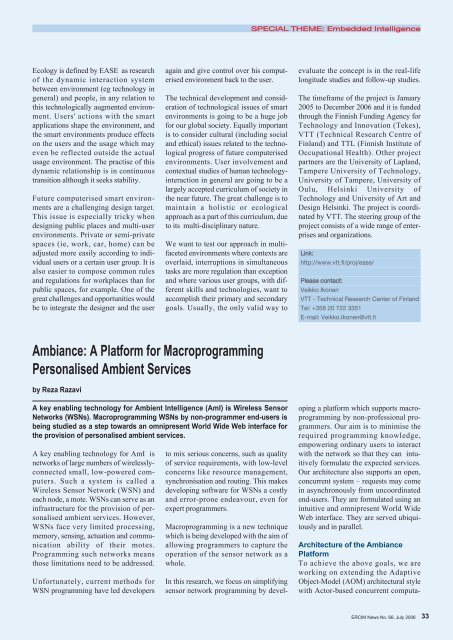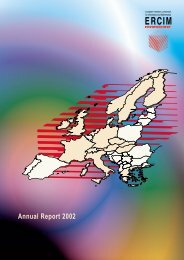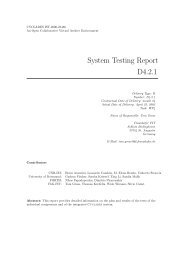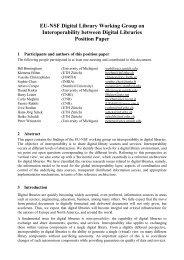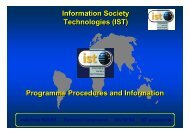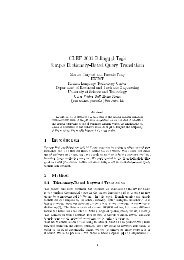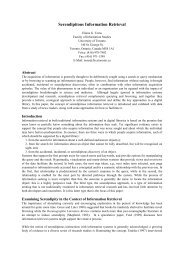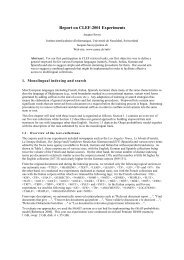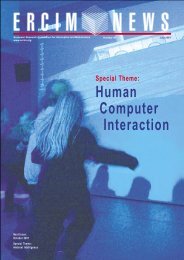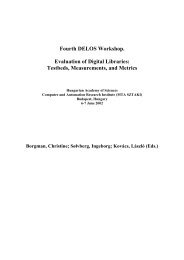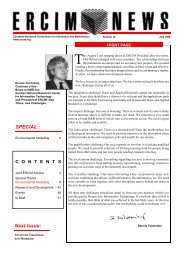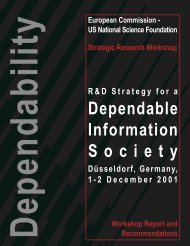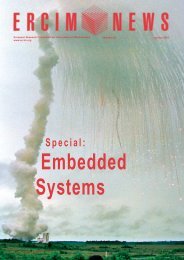Towards a Platform for Widespread Embedded Intelligence - ERCIM
Towards a Platform for Widespread Embedded Intelligence - ERCIM
Towards a Platform for Widespread Embedded Intelligence - ERCIM
Create successful ePaper yourself
Turn your PDF publications into a flip-book with our unique Google optimized e-Paper software.
Ecology is defined by EASE as research<br />
of the dynamic interaction system<br />
between environment (eg technology in<br />
general) and people, in any relation to<br />
this technologically augmented environment.<br />
Users' actions with the smart<br />
applications shape the environment, and<br />
the smart environments produce effects<br />
on the users and the usage which may<br />
even be reflected outside the actual<br />
usage environment. The practise of this<br />
dynamic relationship is in continuous<br />
transition although it seeks stability.<br />
Future computerised smart environments<br />
are a challenging design target.<br />
This issue is especially tricky when<br />
designing public places and multi-user<br />
environments. Private or semi-private<br />
spaces (ie, work, car, home) can be<br />
adjusted more easily according to individual<br />
users or a certain user group. It is<br />
also easier to compose common rules<br />
and regulations <strong>for</strong> workplaces than <strong>for</strong><br />
public spaces, <strong>for</strong> example. One of the<br />
great challenges and opportunities would<br />
be to integrate the designer and the user<br />
again and give control over his computerised<br />
environment back to the user.<br />
The technical development and consideration<br />
of technological issues of smart<br />
environments is going to be a huge job<br />
<strong>for</strong> our global society. Equally important<br />
is to consider cultural (including social<br />
and ethical) issues related to the technological<br />
progress of future computerised<br />
environments. User involvement and<br />
contextual studies of human technologyinteraction<br />
in general are going to be a<br />
largely accepted curriculum of society in<br />
the near future. The great challenge is to<br />
maintain a holistic or ecological<br />
approach as a part of this curriculum, due<br />
to its multi-disciplinary nature.<br />
We want to test our approach in multifaceted<br />
environments where contexts are<br />
overlaid, interruptions in simultaneous<br />
tasks are more regulation than exception<br />
and where various user groups, with different<br />
skills and technologies, want to<br />
accomplish their primary and secondary<br />
goals. Usually, the only valid way to<br />
Ambiance: A <strong>Plat<strong>for</strong>m</strong> <strong>for</strong> Macroprogramming<br />
Personalised Ambient Services<br />
by Reza Razavi<br />
A key enabling technology <strong>for</strong> Ambient <strong>Intelligence</strong> (AmI) is Wireless Sensor<br />
Networks (WSNs). Macroprogramming WSNs by non-programmer end-users is<br />
being studied as a step towards an omnipresent World Wide Web interface <strong>for</strong><br />
the provision of personalised ambient services.<br />
A key enabling technology <strong>for</strong> AmI is<br />
networks of large numbers of wirelesslyconnected<br />
small, low-powered computers.<br />
Such a system is called a<br />
Wireless Sensor Network (WSN) and<br />
each node, a mote. WSNs can serve as an<br />
infrastructure <strong>for</strong> the provision of personalised<br />
ambient services. However,<br />
WSNs face very limited processing,<br />
memory, sensing, actuation and communication<br />
ability of their motes.<br />
Programming such networks means<br />
those limitations need to be addressed.<br />
Un<strong>for</strong>tunately, current methods <strong>for</strong><br />
WSN programming have led developers<br />
to mix serious concerns, such as quality<br />
of service requirements, with low-level<br />
concerns like resource management,<br />
synchronisation and routing. This makes<br />
developing software <strong>for</strong> WSNs a costly<br />
and error-prone endeavour, even <strong>for</strong><br />
expert programmers.<br />
Macroprogramming is a new technique<br />
which is being developed with the aim of<br />
allowing programmers to capture the<br />
operation of the sensor network as a<br />
whole.<br />
In this research, we focus on simplifying<br />
sensor network programming by devel-<br />
SPECIAL THEME: <strong>Embedded</strong> <strong>Intelligence</strong><br />
evaluate the concept is in the real-life<br />
longitude studies and follow-up studies.<br />
The timeframe of the project is January<br />
2005 to December 2006 and it is funded<br />
through the Finnish Funding Agency <strong>for</strong><br />
Technology and Innovation (Tekes),<br />
VTT (Technical Research Centre of<br />
Finland) and TTL (Finnish Institute of<br />
Occupational Health). Other project<br />
partners are the University of Lapland,<br />
Tampere University of Technology,<br />
University of Tampere, University of<br />
Oulu, Helsinki University of<br />
Technology and University of Art and<br />
Design Helsinki. The project is coordinated<br />
by VTT. The steering group of the<br />
project consists of a wide range of enterprises<br />
and organizations.<br />
Link:<br />
http://www.vtt.fi/proj/ease/<br />
Please contact:<br />
Veikko Ikonen<br />
VTT - Technical Research Center of Finland<br />
Tel: +358 20 722 3351<br />
E-mail: Veikko.Ikonen@vtt.fi<br />
oping a plat<strong>for</strong>m which supports macroprogramming<br />
by non-professional programmers.<br />
Our aim is to minimise the<br />
required programming knowledge,<br />
empowering ordinary users to interact<br />
with the network so that they can intuitively<br />
<strong>for</strong>mulate the expected services.<br />
Our architecture also supports an open,<br />
concurrent system – requests may come<br />
in asynchronously from uncoordinated<br />
end-users. They are <strong>for</strong>mulated using an<br />
intuitive and omnipresent World Wide<br />
Web interface. They are served ubiquitously<br />
and in parallel.<br />
Architecture of the Ambiance<br />
<strong>Plat<strong>for</strong>m</strong><br />
To achieve the above goals, we are<br />
working on extending the Adaptive<br />
Object-Model (AOM) architectural style<br />
with Actor-based concurrent computa-<br />
<strong>ERCIM</strong> News No. 66, July 2006 33


